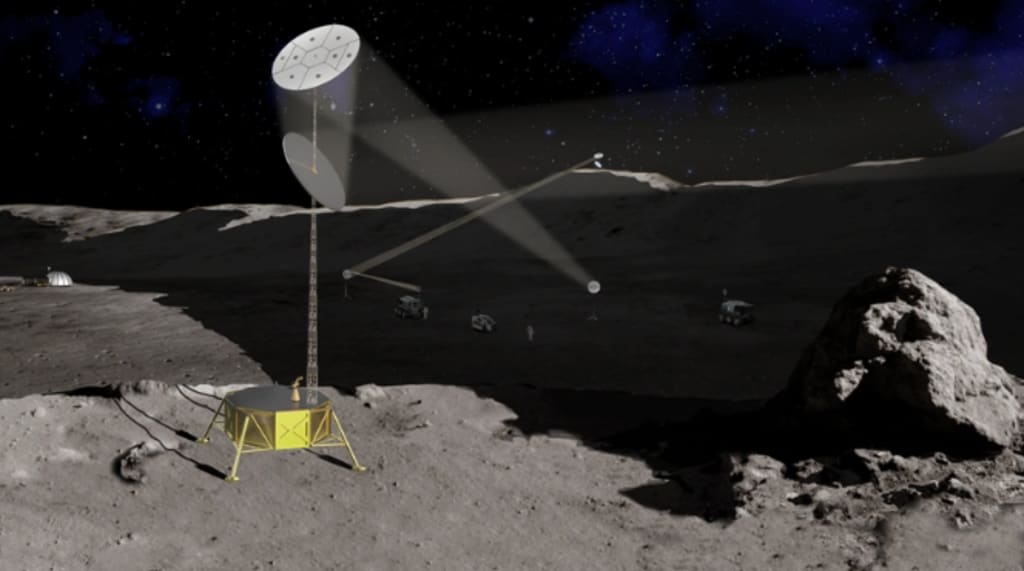Funded Robotics Project Illuminates Lunar Darkness: Introducing Light Bender
Maxar Technologies Develops Innovative Light Reflection System for Moon Exploration

Preparation for the upcoming Artemis missions, NASA is spearheading a groundbreaking project that aims to illuminate isolated regions of the Moon. Through a partnership with startup Maxar Technologies, a NASA-funded robotic light system called Light Bender is currently in development.
Light Bender is designed to harness solar rays and reflect them to solar panels located in shadowed areas on the lunar surface. By doing so, this innovative system ensures that even the darkest regions of the Moon receive a much-needed dose of light.
The installation process of this groundbreaking infrastructure involves a team of robotic assistants. First, a 65-foot pole will be set up, followed by the assembly of two 32-foot reflectors using a robotic arm. Sunlight will bounce from the lower reflector to the top, ultimately reaching the receiver and providing illumination to the targeted area.
According to the development team, these reflectors will be the largest ones ever autonomously assembled in space, highlighting the cutting-edge nature of the project.
The Artemis missions, orchestrated by NASA, have set their sights on exploring the lunar polar regions. These regions are believed to harbor substantial water reserves, which could prove invaluable for future astronauts and potentially host extraterrestrial life. However, establishing missions in these areas poses a challenge due to the persistent darkness. Hence, the creation of a reliable light infrastructure is crucial, and this endeavor relies on advanced robotic technology to overcome the harsh lunar environment.
Sean Dougherty, Maxar's chief robotics architect, explains the underlying concept, stating, "Part of what we're doing is conceptually simple, reflecting sunlight to a solar panel located in the dark. Where it gets complex is doing that without humans involved." Emphasizing the significance of leveraging autonomy, Dougherty adds, "We're leveraging investments in autonomy to study how NASA can use robots to assemble and deploy a set of reflectors that keep sunlight focused on a solar panel operating in the shadows. It's never been done before."
While the Maxar team focuses on developing the robotic operations, NASA will dedicate its efforts to the structural design of the Light Bender system. A "Earth-based" demonstration of the system is scheduled for 2025 and will take place at the NASA Langley facilities, serving as a testament to the project's progress and potential.
With the advent of Light Bender, NASA and Maxar Technologies are paving the way for a new era of lunar exploration. By harnessing the power of robotics and innovative light reflection techniques, humanity's ability to thrive in the harshest extraterrestrial environments is becoming an increasingly achievable reality.
As the NASA-funded project progresses, the collaboration between Maxar Technologies and NASA promises to revolutionize our understanding of lunar exploration. While Maxar focuses on perfecting the robotic operations aspect of the Light Bender system, NASA is committed to designing a structurally sound and efficient infrastructure.
The implications of this pioneering project extend far beyond the bounds of our natural satellite. By illuminating the dark regions of the Moon, scientists hope to unlock valuable resources and expand our understanding of the universe. The lunar polar regions, with their anticipated water reserves, could potentially serve as a critical resource for sustaining long-duration space missions and establishing future human settlements on the Moon.
The challenges associated with lunar exploration are numerous and complex. The absence of a steady light source in certain areas presents a formidable obstacle for human and robotic exploration alike. However, with the advent of Light Bender, NASA and Maxar are poised to overcome this challenge and provide a groundbreaking solution.
The robotic assembly and deployment of the reflectors represent an unprecedented feat of engineering. This endeavor showcases the remarkable advancements made in autonomy and robotics, as well as the tireless pursuit of innovation within the space exploration community.
Looking forward, the planned Earth-based demonstration of the Light Bender system in 2025 will undoubtedly be a pivotal moment. It will serve as a tangible manifestation of years of research, development, and collaboration between Maxar Technologies and NASA. The demonstration will not only validate the effectiveness of the system but also pave the way for future lunar missions, bringing us one step closer to realizing our dreams of space colonization.
With each technological milestone achieved, the boundaries of human exploration are pushed further. The prospect of a future where robots tirelessly toil on the lunar surface, constructing and maintaining essential infrastructure, fuels our imagination and propels us towards a new era of space exploration.
As the Light Bender project progresses, it serves as a testament to the indomitable spirit of scientific discovery and the unwavering dedication of the brilliant minds at Maxar Technologies and NASA. Together, they forge ahead, illuminating the darkest corners of the Moon and shedding light on the limitless possibilities that lie beyond.
About the Creator
Anthony Gatimu
Being a writer,It requires constancy, discipline, and vulnerability.But inside that weakness lies your most noteworthy strength, for it is through your weakness that you interface with perusers on a significant level.






Comments
There are no comments for this story
Be the first to respond and start the conversation.